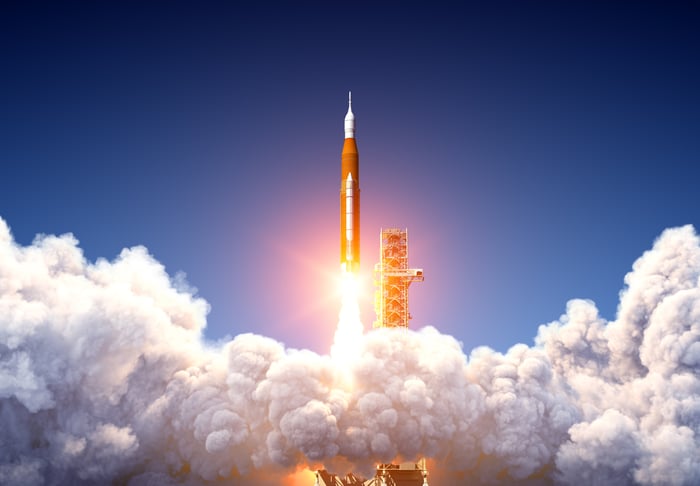When Sir Richard Branson announced last year that his company, Virgin Galactic, would begin charging $450,000 a ticket for tourist flights to space and back, minds boggled at the price tag. But if $450,000 sounds like a lot of money to you, you'd better sit down before I tell you how much it will cost NASA to send astronauts to the moon again.
$4.1 billion per four-person flight.
That's $1,025,000,000 per astronaut.

Image source: Getty Images.
NASA's incredible inflating price tag
This is according to NASA Inspector General Paul Martin, head of the Office of Inspector General of the National Aeronautics Space Administration (the OIG of NASA, for lovers of acronyms). Testifying before the U.S. House of Representatives Subcommittee on Space and Aeronautics earlier this month, Martin confirmed the findings of an OIG audit of NASA performed late last year.
In particular, he confirmed that "the current production and operations cost of a single SLS/Orion system [will be] $4.1 billion per launch for Artemis I through IV."
Does this number shock you? It seems to have shocked Mr. Martin -- and for good reason. Recall that back in 2012, back when NASA's Space Launch System (SLS -- the new moon rocket) was first announced, NASA predicted that each SLS would cost about $500 million. By last year, that number had already ballooned to cost $1.5 billion, or even $2 billion (depending on whom you asked). Now, it appears the number has exploded higher again, to a staggering eight times initial projections.
Commenting on how SLS costs have gotten way, way out of control, the inspector general warned that the current price tag for each moon mission "strikes us as unsustainable." As he explained, OIG's estimate includes a cost of:
- $2.2 billion per SLS rocket.
- $1 billion more for the Orion spacecraft it carries.
- $300 million for the Orion's service module (i.e. its primary power and propulsion component).
- And $568 million more for ground systems to support the launch.
This cost does not include the $40 billion NASA has already spent to develop SLS and Orion. Amortized across an anticipated 10 total Artemis missions, though, that would add $4 billion to the total cost of each launch -- roughly doubling launch costs once again, to more than $8 billion each.
"Unsustainable," indeed.
What it means for investors
I don't think it's overstating things much to say that once taxpayers (i.e. voters) realize how very much this project is costing, they're not going to be happy. Unhappy voters could in turn create unhappy legislators (in charge of NASA's funding). And that, in turn, it could cost NASA the financial support it needs to return to the moon.
If that happens, key Project Artemis contractors that include primary SLS contractor Boeing (BA 0.39%), Orion builder Lockheed Martin (LMT -0.55%), and engine builders Northrop Grumman (NOC 1.82%) and Aerojet Rocketdyne (AJRD) could all find that, instead of reaping $8 billion per launch in revenue, their revenues will dry up when Project Artemis is canceled, or recontracted to a cheaper provider such as SpaceX.
If this happens, Boeing will bear much of the blame.
Martin described Boeing's performance on SLS as "very poor ... poor planning and poor execution." Indeed, Boeing's failures may be matched only by the "poor project management and contract oversight" at NASA itself. Martin seemed particularly disappointed in NASA's decision to pay Boeing, Lockheed, and the other contractors "cost-plus" for their work on SLS, guaranteeing them a profit margin no matter how "poorly" they executed on their contracts.
Boeing replies that it has actually spent only "a quarter of the cost of the Saturn V" to develop SLS. But however much (or little) has been spent until now doesn't change the fact that if each upcoming SLS launch costs $4.1 billion, this new rocket will be much more expensive than the old Saturn V that carried Apollo 11.
Reporting on the 50th anniversary of the Apollo 11 moon landing two years ago, Forbes calculated that the Apollo 11 mission cost $355 million to launch in 1969. Adjusted for inflation, that works out to about $2.7 billion in today's dollars -- 34% cheaper than the projected SLS launch cost.
What happens next
So what's the solution? At this point, Project Artemis probably has enough momentum to proceed through Artemis III at least -- the rocket that will send the first astronauts back to the moon in 2025. Artemis IV anticipates an upgrade to a new "Block 1B" version of SLS. Before it arrives, though, the success of Artemis III could sow the seeds of SLS' eventual cancellation and replacement with cheaper rockets from SpaceX.
This is because the spaceship that will actually land on the moon in 2025 will be a SpaceX-built Human Landing System costing $2.9 billion -- derived from a SpaceX-built "Starship" rocket that Elon Musk estimates will cost only $10 million per launch. When you consider furthermore that Musk estimates it cost SpaceX only $2 billion to $4 billion to develop Starship -- versus $50 billion to develop Saturn V, or $40 billion to develop SLS -- it quickly becomes apparent that SpaceX is the only company offering "sustainable" prices for long-term lunar exploration.
Considering that, in making his recommendations to Congress, the inspector general suggested eliminating "sole-source, cost-plus contracts" such as have been the norm until now, and switching from "single use" rockets and spaceships (like SLS and Orion) to use "emerging commercial space flight systems" that are reusable, like SpaceX's Starship, I think it's more likely than not that Artemis III will be the last SLS rocket to fly.





